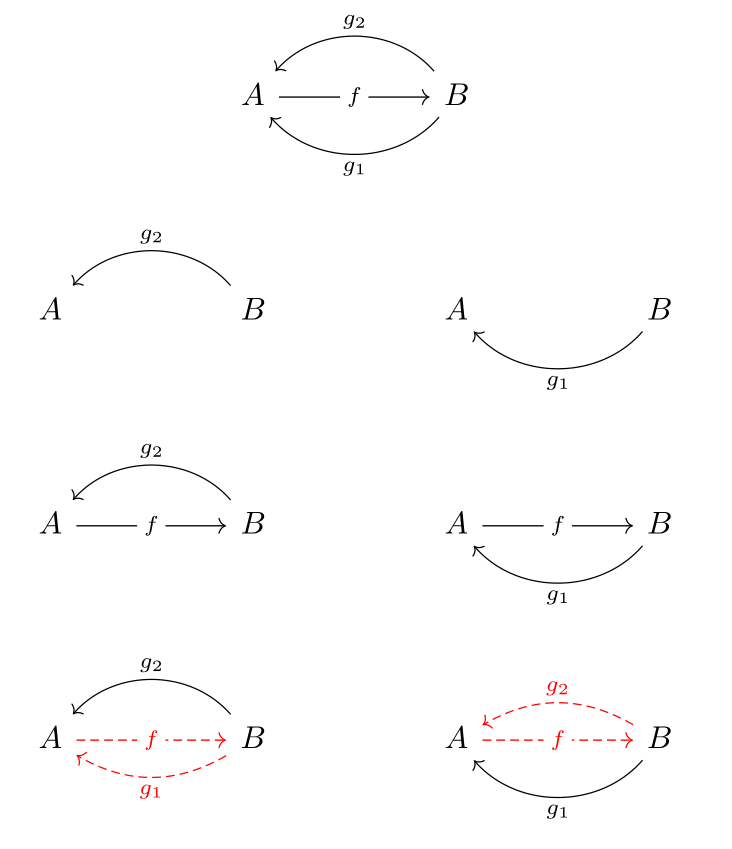Isomorphism
For functions between sets, we defined the notion of injective, surjective and bijective/isomorphic functions. We do the same for morphisms between objects of a category. This card covers isomorphisms; other cards cover monomorphisms and epimorphisms.
An isomorphism is defined as follows:
Isomorphism. Definition.
Let \( C \) be a category. A morphism \( f \in \cathom{C}(A, B) \) is an isomorphism iff there exists a morphism \( g \in \cathom{C}(B, A) \) such that both:
\( g \) is said to be a (two sided) inverse of \( f \).
Uniqueness
Can \( f \) have multiple inverses? Uniqueness of \( g \) is not built into the definition above; however, it is indeed true that \( g \) is unique:
Theorem
An inverse of an isomorphism is unique.
Proof on the other side.
Since an inverse is unique, there is no ambiguity in denoting it as \( f^{-1} \).
Auxiliary propositions
Here are three useful propositions related to isomorphisms:
- Every identity is an isomorphism and is its own inverse.
- If \( f \) is an isomorphism then \( f^{-1} \) is an isomorphism and \( (f^{-1})^{-1} = f \).
- If \( f \in \cathom{C}(A, B) \) and \( g \in \cathom{C}(B, C) \) are isomorphisms, then \( g\, f \) is an isomorphism and \( (g \, f)^{-1} = f^{-1}g^{-1} \).
An inverse of an isomorphism is unique. Proof.
Let \( f : A \to B \) be a morphism, let \( g_1 : B \to A \) be a left-inverse of \( f \) and let \( g_2 : B \to A \) be a right-inverse of \( f \). Thus,
By composing \( g_1 \), \( f \) and \( g_2 \) then applying associativity we see that \( g_1 = g_2 \) and that this morphism is the unique inverse:
Intuition
The diagram below might spark some intuition. The composition of \( g_1 \), \( f \) and \( g_2 \) is presented in the two possible: the left side constructs the path beginning with \( g_2 \) and the right side beginning with \( g_1 \).

One intuitively appealing description of the diagram is that there is a three step journey where the middle leg, \( f \), can negate either the first leg, \( g_2 \), or the last leg \( g_1 \). Regardless of which one is negated, the overall journey is the same (associativity). If \( g_1 \) is negated, then the journey is \( g_2 \), and if \( g_2 \) is negated the journey is \( g_1 \), but either way, the journel is the same, so \( g_1 = g_2 \).
Departure from \( \mathrm{Set} \)
While many aspects of functions on sets transfer nicely to the catagorical setting, it is noteworthy that a morphism that is monomorphic and epimorphic (concepts which are analogous to injectivity and surjectivity of functions) may not necessarily be isomorphic. In comparison, a function is both injective and surjective iff it is bijective.
